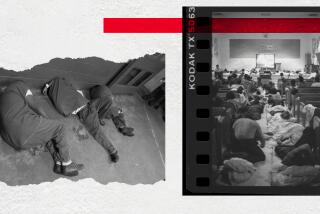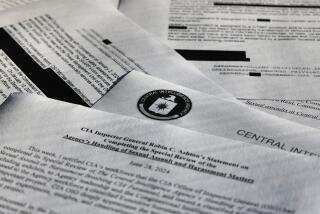Memos shed light on CIA use of sleep deprivation
- Share via
WASHINGTON — As President Obama prepared last month to release secret memos on the CIA’s use of severe interrogation methods, the White House fielded a flurry of last-minute appeals.
One came from former CIA Director Michael V. Hayden, who expressed disbelief that the administration was prepared to expose methods it might later decide it needed.
“Are you telling me that under all conditions of threat, you will never interfere with the sleep cycle of a detainee?” Hayden asked a top White House official, according to sources familiar with the exchange.
From the beginning, sleep deprivation had been one of the most important elements in the CIA’s interrogation program, used to help break dozens of suspected terrorists, far more than the most violent approaches. And it is among the methods the agency fought hardest to keep.
The technique is now prohibited by President Obama’s ban in January on harsh interrogation methods, although a task force is reviewing its use along with other interrogation methods the agency might employ in the future.
Because of its effectiveness -- as well as the perception that it was less objectionable than waterboarding, head-slamming or forced nudity -- sleep deprivation may be seen as a tempting technique to restore.
But the Justice Department memos released last month by Obama, as well as information provided by officials familiar with the program, indicate that the method, which involves forcing chained prisoners to stand, sometimes for days on end, was more controversial within the U.S. intelligence community than was widely known.
A CIA inspector general’s report issued in 2004 was more critical of the agency’s use of sleep deprivation than it was of any other method besides waterboarding, according to officials familiar with the document, because of how the technique was applied.
The prisoners had their feet shackled to the floor and their hands cuffed close to their chins, according to the Justice Department memos.
Detainees were clad only in diapers and not allowed to feed themselves. A prisoner who started to drift off to sleep would tilt over and be caught by his chains.
The memos said that more than 25 of the CIA’s prisoners were subjected to sleep deprivation. At one point, the agency was allowed to keep prisoners awake for as long as 11 days; the limit was later reduced to just over a week.
According to the memos, medical personnel were to make sure prisoners weren’t injured. But a 2007 Red Cross report on the CIA program said that detainees’ wrists and ankles bore scars from their shackles.
When detainees could no longer stand, they could be laid on the prison floor with their limbs “anchored to a far point on the floor in such a manner that the arms cannot be bent or used for balance or comfort,” a May 10, 2005, memo said.
“The position is sufficiently uncomfortable to detainees to deprive them of unbroken sleep, while allowing their lower limbs to recover from the effects of standing,” it said.
In the Red Cross report, prisoners said they were also subjected to loud music and repetitive noise.
“I was kept sitting on a chair, shackled by hands and feet for two to three weeks,” said suspected Al Qaeda operative Abu Zubaydah, the first prisoner captured by the CIA, according to the Red Cross report. “If I started to fall asleep, a guard would come and spray water in my face.”
In the Justice Department memos, sleep deprivation was described as part of a “baseline” phase of interrogation, categorized as less severe than other “corrective” or “coercive” methods.
Within the CIA, sleep deprivation was seen as a method with the unique advantage of eroding prisoners’ will to resist without causing lasting harm.
“Waterboarding was obviously the most controversial,” said a former senior U.S. government official who was briefed extensively on CIA interrogation operations. But “sleep deprivation is probably the most effective thing they had going.”
Facing congressional efforts in 2005 and 2006 to block the use of certain techniques, CIA lawyers and Bush administration officials lobbied to keep a core set of methods, including sleep deprivation.
In 2007, after a U.S. Supreme Court ruling compelled the White House to bring the CIA program into compliance with the Geneva Convention, President Bush signed an executive order that outlined detainees’ rights to the “basic necessities of life.” The order listed “adequate food and water, shelter from the elements, necessary clothing” and protection from extreme heat and cold. But it made no mention of sleep as a basic necessity.
Current and former U.S. intelligence officials said sleep deprivation multiplied the coercive power of other techniques that included face-slapping and confinement in small boxes.
“It was viewed as a tool that enabled all the others,” said a former CIA official directly involved in the program. The former official, like others, described internal thinking on condition of anonymity.
The Justice Department memos also cited research that suggested sleep deprivation was not harmful.
“Experience with sleep deprivation shows that ‘surprisingly, little seemed to go wrong with the subjects physically,’ ” said the May 10, 2005, Justice Department memo -- one of many instances in which government lawyers cited scientific papers in asserting that the program was safe.
But some authors of those studies have since said that the conclusions of their research were grossly misapplied.
James Horne, director of the Sleep Research Center at Loughborough University in Britain, said he was never consulted by U.S. officials and didn’t know how his work was being used until the memos were released.
“My response was shocked concern,” Horne said in an e-mail interview. Just because the pain of sleep deprivation “can’t be measured in terms of physical injury or appearance . . . does not mean that the mental anguish is not as bad.”
Horne said that it was dangerous for the CIA to extrapolate from independent research in which subjects had gone for as long as a week without sleep, voluntarily, and were free to eat, rest, watch television or leave the research facility at any time. By contrast, CIA prisoners were subjected to major additional stresses that risk physical and mental collapse.
“To claim that 180 hours is safe in these respects is nonsense,” Horne wrote in a separate online posting. Even if sleep deprivation succeeded in getting prisoners to talk, he said, “I would doubt whether the state of mind would be able to produce credible information, unaffected by delusion, fantasy or suggestibility.”
--
More to Read
Sign up for Essential California
The most important California stories and recommendations in your inbox every morning.
You may occasionally receive promotional content from the Los Angeles Times.










